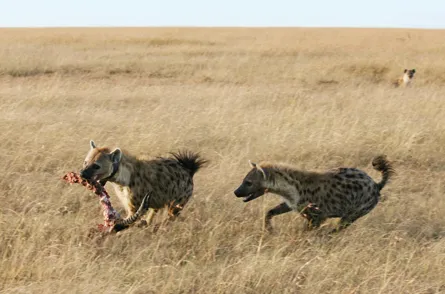Status among hyenas sounds like a laughing matter.

Spotted hyenas may not be amused, but they do make noises that to human ears sound like laughter. Biologists refer to this classic hyena laugh, a burst of short he-hes, as a giggle call.
Among captive hyenas housed in pairs, those calls may carry information about which animal dominates, says neuroscientist Frédéric Theunissen of the University of California, Berkeley. A top hyena giggles with a relatively uniform string of “he-he” sounds, Theunissen and his colleagues report March 30 in BMC Ecology. The subordinate giggles too, but with more variable noises.
Their study takes “the first step in deciphering what information is in a giggle,” Theunissen says. If the rank pattern holds up in larger groups and if the hyenas themselves pay attention to it, the upper-crust or lowlife giggles might help the animals navigate their elaborate social relationships, he says. Decoding the sounds, he says, could yield insights into the evolution of communication in complex societies, including humans’.
“Their vocalizations have received surprisingly little attention to date in the literature,” says another hyena researcher, Kay Holekamp of Michigan State University in East Lansing, who wasn’t part of this study. Yet their vocal repertoire is very complex, she says “and the hyenas can clearly use sound to communicate many different types of information.”
The spotted species, Crocuta crocuta, makes 10 to 15 different kinds of sounds, some of them quite odd, Theunissen says. The hyenas give loud whoops reported to carry for kilometers, and low-pitched rhythmic groans he describes as “melodic.”
And these hyenas “laugh,” although brown hyenas, which aren’t social, don’t. “We call it the laugh, but it’s produced in situations where there’s some conflict and frustration and stress,” Theunissen says, such as when animals jostle to feed at a kill. “Or if the kill is being mobbed by a lion, all the hyenas will giggle together,” he says.
To figure out the calls, Theunissen and his colleagues recorded and analyzed laughter of 17 hyenas in a colony at UC Berkeley’s field station. “The way we did this was by teasing the animals with their lunch,” he says. As a researcher dangled a piece of meat out of reach outside a hyena’s enclosure, the test subject readily giggled.
Analyzing the recordings showed that each animal’s giggles had a distinctive quality, much as each human’s voice is different. That finding didn’t intrigue Theunissen so much as the possibility that giggles vary with rank.
Rank is a big deal in spotted hyena societies, where all females from high-rankers down to losers outrank all the males. Cubs of either sex get the privileges of their mother’s rank, such as feeding at a kill with her, while they’re young. “It helps to have a strong mom,” Theunissen says.
“In nature, social relationships among hyenas are much more complicated than what can be simulated in the captive setting,” cautions Holekamp. She’s planning to work with Theunissen on future projects, but she says she’s withholding judgment on high-rank giggling until there’s more information about the laughter in the wild.






